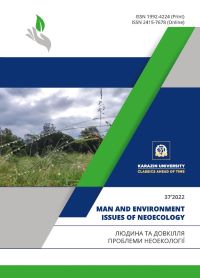The concept of agroecosystems as a theoretical basis of ecologically tolerant nature management
Abstract
Purpose. The main goal of the authors was to prove the suitability of the concept of noosphere ecosystems to interpret not only ecological phenomena and processes, but also phenomena of socio-natural content, and, subsequently, possibly geopolitical processes, in particular, spatial expansion of certain ethnic groups.
Methods. In the course of our research a set of methodological approaches and scientific methods was used. The set of methods includes: empirical, which was implemented in the sequential implementation of the following operations: observation, modeling, forecasting; comparative – was implemented while comparing the main functions of natural and agroecosystems.
Results. The formation of agricultural areas is the second stage in the transformation of natural ecosystems into agroecosystems. The main assumption of our work is the possibility of the existence of an agricultural system that has a dual character of borders. Our assumption was tested on the territory of Kharkiv region – one of the most developed agricultural territories of Ukraine. Based on the assumption that soil is both a condition and a result of human agricultural activity, as well as the fact that it connects natural and economic boundaries of agroecosystems in space-time, we calculated the balance of matter in the soil and coefficient of ecological danger. Mapping the values of the coefficient of ecological danger showed that out of 429 farms in the region, only 7 farms have values of the coefficient more than 1. This means that under the conditions of intensive agriculture there is a constant shortage of matter and energy, which leads to a negative balance of humus in the soil. According to the author's concept, one of the main causes of environmental problems lies in the different rates of development of nature and society.
Conclusions. The “memory” of the former structurally and informationally unchanging biosphere is embedded in agroecosystems. According to modern notions of rhizome, such a memory is soil. Such “memory” at the level of agroecosystems provides self-regulation of the “human ecosystem” through both direct regulation of the human population (disease, war) and indirect impact on planetary spatial structures. In particular, due to the preservation of certain proportions between the territories with “naturalized” and “commodity” economy.
Downloads
Published
Issue
Section
License
Copyright (c) 2022 Сонько С. П., Максименко Н. В., Василенко О. В., Гурський І. М., Шиян Д. В., Зозуля І. І.

This work is licensed under a Creative Commons Attribution 4.0 International License.
Автори, які публікуються у цьому журналі, погоджуються з наступними умовами:- Автори залишають за собою право на авторство своєї роботи та передають журналу право першої публікації цієї роботи на умовах ліцензії Creative Commons Attribution License, котра дозволяє іншим особам вільно розповсюджувати опубліковану роботу з обов'язковим посиланням на авторів оригінальної роботи та першу публікацію роботи у цьому журналі.
- Автори мають право укладати самостійні додаткові угоди щодо неексклюзивного розповсюдження роботи у тому вигляді, в якому вона була опублікована цим журналом (наприклад, розміщувати роботу в електронному сховищі установи або публікувати у складі монографії), за умови збереження посилання на першу публікацію роботи у цьому журналі.
- Політика журналу дозволяє і заохочує розміщення авторами в мережі Інтернет (наприклад, у сховищах установ або на особистих веб-сайтах) рукопису роботи, як до подання цього рукопису до редакції, так і під час його редакційного опрацювання, оскільки це сприяє виникненню продуктивної наукової дискусії та позитивно позначається на оперативності та динаміці цитування опублікованої роботи (див. The Effect of Open Access).

